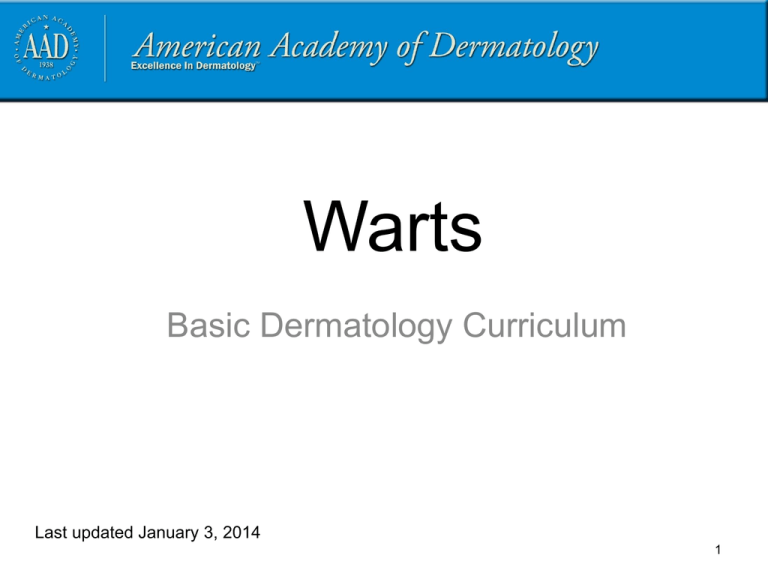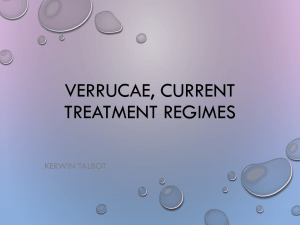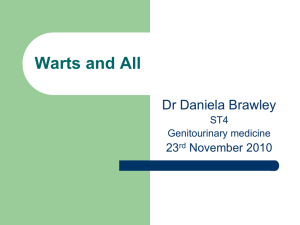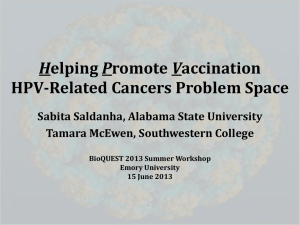
Warts
Basic Dermatology Curriculum
Last updated January 3, 2014
1
Module Instructions
The following module contains a number
of blue, underlined terms which are
hyperlinked to the dermatology glossary,
an illustrated interactive guide to clinical
dermatology and dermatopathology.
We encourage the learner to read all the
hyperlinked information.
2
Goals and Objectives
The purpose of this module is to help medical students
develop a clinical approach to the evaluation and initial
management of patients presenting with warts.
By completing this module, the learner will be able to:
• Identify and describe the morphology of various types of
warts
• Discuss the pathogenesis of warts
• Develop an initial treatment plan for a patient with warts
• Determine when vaccines can be helpful for wart
management
3
Case One
Megan Driskell
4
Case One: History
HPI: Megan is an 8-year-old girl who presents to her
pediatrician’s office with bumps on her fingers and
hands. They have been present for 3 months without
change and are asymptomatic.
PMH: no chronic illnesses or prior hospitalizations
Allergies: no known allergies
Medications: none
Family history: no affected family members
Social history: lives at home with parents and attends
school
ROS: negative
5
Case One: Skin Exam
6
Case One: Question 1
How would you describe these
lesions?
a. Hyperkeratotic and umbilicated papules
and nodules
b. Hyperkeratotic, endophytic papules and
nodules
c. Hyperkeratotic, exophytic papules and
nodules
d. Smooth and umbilicated papules and
nodules
e. Smooth, exophytic papules and nodules
7
Case One: Question 1
Answer: c
How would you describe these lesions?
a. Hyperkeratotic and umbilicated papules and nodules (these
papules are not umbilicated)
b. Hyperkeratotic, endophytic papules and nodules (these
papules are growing outward, not inward)
c. Hyperkeratotic, exophytic papules and nodules
d. Smooth and umbilicated (marked by a depressed spot)
papules and nodules (more characteristic of molluscum
contagiosum)
e. Smooth, exophytic papules and nodules (these papules are
not smooth)
8
Clinical Features of Verruca
Vulgaris
• Hyperkeratotic, exophytic
(growing outward), domeshaped papules or nodules
• Most common on fingers,
dorsal hands, knees or elbows
but may occur anywhere
• Punctate black dots
representing thrombosed
capillaries
• May koebnerize – spread with
skin trauma
9
Case One: Question 2
Verruca vulgaris is caused by:
a.
b.
c.
d.
e.
Human immunodeficiency virus
Human papillomavirus
Pox virus
Herpes virus
Varicella-zoster virus
10
Case One: Question 2
Answer: b
Verruca vulgaris is caused by:
a.
b.
c.
d.
e.
Human immunodeficiency virus
Human papillomavirus
Pox virus
Herpes virus
Varicella-zoster virus
11
Human Papillomavirus (HPV):
Overview
Warts are caused by HPV
HPV infects skin and mucosal epithelia
Infection causes hyperplasia of the epithelium =
a wart
HPV infects the basal keratinocytes of cutaneous
and mucosal epithelium
12
Role of HPV in Cutaneous
Disease
HPV can be transmitted by skin-to-skin
contact or through contaminated surfaces
or objects
• Patients can also spread virus from a wart to
unaffected skin
The type of HPV influences the wart morphology
Type of Wart
HPV Type
Verruca vulgaris: common warts
HPV 2,4
Verrucae plana: flat warts
HPV 3, 10
Palmoplantar warts
HPV 1
Condylomata acuminata: external
genital warts
HPV 6, 11, 16, 18, 31,
and more
13
Epidemiology
One of the top three skin problems in
children
Peak prevalence is during adolescence
(13-16 years old)
about 5-20% of teens are affected
Also common younger and older people
School-age children (5-12 years) 1-5% also
commonly found in young adults
Males and females are equally affected
14
Clinical Features of Verrucae
Planae: Flat Warts
• Skin-colored or pink
• Smooth-surfaced,
slightly elevated, flattopped papules
• Dorsal hands, arms,
face (exposed
surfaces)
15
Clinical Features of Palmoplantar
Verruca
• Thick, endophytic
(depressed into skin of
sole) papules
• Mosaic warts: plantar
warts coalescing into
large plaques
16
Clinical Features of Palmoplantar
Verruca
• Can accumulate a
thick callus over and
around the wart
• Plantar warts may be
painful when walking
17
General Treatment Principles
Observation: Chance of spontaneous
resolution at 2 years is over 75%
Supported by cure rates of 20-70% in placebo
groups of trials
Multiple treatments are almost always
needed for any treatment modality (laser,
acids, cryotherapy, etc.)
Start with therapies that minimize side effects
and risk of scarring
18
Common Wart Treatment
Options
Treatments are often destructive and/or stimulate the
immune system
There is no specific anti-HPV therapy (unlike HIV and viral
hepatitis)
Destructive/irritating therapies may also be effective by
triggering an immune response
Primarily Irritating or Destructive
Primarily Immune-stimulating
Cryotherapy*
Imiquimod
Salicylic acid*
Candida antigen (IL)
Tretinoin cream
Immunotherapy: Squaric acid or DCNB
Shave removal
Adhesive tape
Laser
*= very common therapy, DCNB = dinitrochlorobenzene, IL=intralesional
19
First Line Approaches
to Wart Treatment
Number
of Warts
Hand & Foot
Face
Other Sites
Few
Cryotherapy
Salicylic acid
Adhesive tape
Laser
Cryotherapy
Shave (surgical)
removal
Cryotherapy
Salicylic acid
Many
Salicylic acid
Cryotherapy
Squaric acid or DCNB
Laser
Cryotherapy
Tretinoin cream
Imiquimod
Tretinoin cream
Squaric acid or DCNB
20
First Line Approaches to
Wart Treatment
Cryotherapy – liquid nitrogen (see slides 21-23)
Salicylic acid – chemically irritating, destructive (see slide
24)
For patients who do not respond to the above therapies,
consider referral to a dermatologist
Other therapies that may be used include:
Laser: pulse dye laser
Topical immunostimulants: Squaric acid
Intralesional injections of immune stimulants: Candida antigen
Intralesional injections of chemotherapy: bleomycin
21
Cryotherapy
Click here for an instructional video on cryotherapy
Side effects of cryotherapy include:
• PIPA (post-inflammatory pigment alteration)
•
•
•
•
– hyperpigmentation or hypopigmentation (see photos
below)
PostPre-
Scar
Pain
Blister
Nail dystrophy
22
Side Effects of Cryotherapy
Post inflammatory
hyperpigmentation
after cryotherapy
Ring Wart post-cryotherapy
23
Salicylic acid 17- 40%
Mechanism: Keratolytic, loosens connections between
keratinocytes, infected with HPV
Applied and changed every 1-2 days, under occlusion
(under tape or a bandaid)
Efficacy: Number Needed to Treat is 2-15, similar to
cryotherapy alone
Cure rate improved by combining salicylic acid and
cryotherapy
Adverse effects: erythema, peeling, irritation,
maceration (due to occlusion)
24
Case One: Question 3
Megan and her mom have done
some reading online about wart
treatments. They ask about several
treatments. Which of their
suggestions below do you suggest
against?
a. cryotherapy
b. excision
c. imiquimod
d. squaric acid
25
Case One: Question 3
Answer: b. excision
Which of their suggestions below
do you suggest against?
a. cryotherapy
b. excision
c. imiquimod
d. squaric acid
26
Number
of Warts
Few
Many
•
•
Hand & Foot
Face
Question
3
Cryotherapy
Cryotherapy
Salicylic acid
Adhesive tape
Laser
Exicision
Salicylic acid
Cryotherapy
Squaric acid or DCNB
Laser
Cryotherapy
Tretinoin cream
Other Sites
Cryotherapy
Salicylic acid
Imiquimod
Tretinoin cream
Squaric acid or DCNB
Answer b. excision – this is the least preferred therapy for this child with
multiple warts on her hands
– Excision is least favored because it is invasive, will leave scars and often does
not completely eliminate HPV virus
Imiquimod is often less effective for this site but is not invasive like surgery
Cryotherapy, Salicyclic acid, and Squaric acid and DCNB are more favored (bold
print above)
– Cryotherapy and laser can be painful, especially for children, and requires
multiple treatments
– Salicyclic acid takes several weeks to take effect and can be challenging to keep
on the fingers and hands
Case 2, Question 1
What is your favored
therapy for this 6year-old with flat
warts on his face?
a.
b.
c.
d.
Imiquimod
Salicylic acid
Shave removal
Topical tretinoin
28
Number
of Warts
Few
Many
Hand & Foot
Face
Other Sites
Case
2,
Question
1
Cryotherapy
Cryotherapy
Salicylic acid
Adhesive tape
Laser
Excision/shave
removal
Salicylic acid
Cryotherapy
Squaric acid or DCNB
Laser
Cryotherapy
Tretinoin cream
Cryotherapy
Salicylic acid
Imiquimod
Tretinoin cream
Squaric acid or DCNB
Answer d. tretinoin cream -- the preferred treatment for this
child with muliple warts on his face
a.
b.
c.
Imiquimod – not preferred because it can cause significant
inflammation with erythema, crusting, and irritation
Salicylic acid – not preferred because it can also cause significant
inflammation and is difficult to cover on the face
Shave removal – not preferred because of the risk of scarring as
well as recurrence
29
Case 3, Question 1
This 32-year-old woman has a
single wart on her foot. What is
your preferred approach with
cryotherapy?
a.
b.
c.
d.
Freeze for 10 seconds, one time
Freeze for 30 seconds, one time
Freeze for 10 seconds, two times
Freeze for 30 seconds, two times
30
Case 3, Question 1
Answer d. Freeze for 30 seconds, two
times
Options a and c would have too short an
application time (freeze time) to do
sufficient damage.
Two freeze cycles performed around the
wart being allowed to thaw is more
effective so options a and b are not
preferred.
a. Freeze for 10 seconds, one time
b. Freeze for 30 seconds, one time
c. Freeze for 10 seconds, two times
Treatment is also more effective if
the thick overlying callus is
removed – either sharply at the
office or intermittently by the
patient with a pumice stone at
home
31
Case Four
Jonathan Cohen
32
Case Two: History
HPI: Mr. Cohen is a 21-year-old man who comes
into the STD clinic because of an increasing
number of bumps on his penis over the last year.
PMH: no chronic illnesses or prior hospitalizations
Allergies: no known allergies
Medications: none
Family history: noncontributory
Social history: studying economics at a nearby
university
ROS: negative
33
Case Four: Skin Exam
34
Case Four: Question 1
How would you describe these lesions?
a.
b.
c.
d.
Pearly, vesicular papules
Smooth, indurated plaques
Soft, sessile papules
Waxy, stuck-on plaques
Case Four: Question 1
Answer: c
How would you describe these lesions?
a.
b.
c.
d.
Pearly, vesicular papules
Smooth, indurated plaques
Soft, sessile papules
Waxy, stuck-on plaques
Clinical Features of
external genital warts
• Soft, rather than hard
hyperkeratotic
• Sessile (broad based)
papules
• May be papules or large
confluent plaques
• External genitalia,
perineum, perianal,
inguinal fold
37
Comparison of molluscum and
genital warts
Molluscum Contagiosum
External Genital Warts
(smooth, dome-shaped papules with
central umbilication)
(hyperkeratotic, exophytic
papules and plaques)
Case Four: Question 2
What additional information is especially
important to care for this patient?
a.
b.
c.
d.
Medications
Sexual history
Surgical history
Allergies
39
Case Four: Question 2
Answer: b. Sexual history
What additional information is especially
important to care for this patient?
Why:
to determine if the patient is at risk for anal HPV
infection
to discuss the contagious nature and risk of
spreading to others and receipt from others
to consider symptoms of additional concomitant STI
40
External Genital Warts (EGW)
HPV infection is one of the most common STIs
• Peak prevalence: women 20-24yo, men 25-29yo
• Risk factors: sexual intercourse at an early age,
numerous partners, unprotected exposure
Effective prophylactic HPV vaccine is available for
prevention of genital warts
41
HPV Infection
• Genital HPV infection is transmitted by sexual
contact from partners with clinical or subclinical
infection
• Some HPV types are associated with neoplasia (16,
18,31, 33-35, 40, 45)
Immunosuppression (organ transplant, HIV) can
lead to infections that are more:
• frequent, persistent, and difficult to treatment
• Patients with HIV and anal warts are also at
higher risk of anal squamous cell carcinoma
42
Case Four: Question 3
Further discussion with Jonathan reveals
that he has HIV and has had anal sex.
Infection with which HPV type is
concerning for anal SCC?
a.
b.
c.
d.
e.
1
2
6
11
34
43
Case Four: Question 3
Answer: e
Infection with which HPV type is concerning for
anal SCC?
a. 1
b. 2
c. 6
d. 11
e. 34
Infection with some HPV types (16, 18,31, 33-35, 40,
45) is more highly associated with squamous cell
carcinoma, especially in patients with
immunosuppression, such as from HIV.
44
Case Four: Question 4
Which of the following treatments could
you use for external genital warts?
a.
b.
c.
d.
Cryotherapy
Imiquimod
Podophyllin
All of the above
45
Case Four: Question 4
Answer: d
Which of the following treatments could you use for
external genital warts?
a. Cryotherapy (liquid nitrogen is used to freeze and destroy
the infected tissue)
b. Imiquimod (interferon inducer is topically applied 3x per
week for 16 weeks)
c. Podophyllin (this anti-mitotic agent is topically applied,
twice daily for 3 days, wait 4 days, then repeat the cycle)
d. All of the above
46
Treatment (cont.)
Surgical (destructive) methods can be
used to treat genital warts
Always use protective mask due
• Laser
to aerosolized HPV virus in the
smoke plume
• Electrocaudery
• Scissor or Shave debulking
• In addition, it is important to counsel
patients about the risk of transmission and
malignancy
– CDC patient handout
47
Prevention: HPV Vaccine
Two HPV vaccines are licensed by the FDA and
recommended by the CDC
• Gardasil™ and Cervarix™
Both vaccines are effective against HPV types 16
and 18, which cause most cervical cancers
48
Prevention: HPV Vaccine
Gardasil: quadrivalent vaccine against HPV 6,
11, 16, 18
FDA-approved:
for females and males, 9-26 years old
to prevent gential warts and HPV-related genital
cancers
Ceravix: bivalent vaccine against HPV 16, 18
FDA-approved:
for females 10-25 years old (not approved for males)
to prevent HPV-related genital cancers
49
Case 5, Question 1
• Parker is a 13-year old girl with warts on her
fingers. She and her mother have heard that
there is a vaccine that can treat warts and they
want Parker to receive it. What is the best
response to this request?
a.
b.
c.
d.
No, because she’s too young to get the vaccine.
No, because the types of warts (HPV) are different.
Yes, it will help treat and prevent warts.
Yes, it’s approved for this condition
Case 5, Question 1
a.
b.
c.
d.
No, because she’s too young to get the vaccine.
No, because the types of warts (HPV types) are different.
Yes, it will help treat and prevent warts.
Yes, it’s approved for this condition
Answer b.
The HPV vaccines are FDA-approved for males and females
9-26 years old (option a) for prevention, not treatment (option
c) of external genital warts and HPV-associated genital
cancers (option d), not common warts on the hands, face, feet,
etc.
The FDA-approved vaccines are not composed of the HPV
types that cause common warts (correct answer, option b)
Take Home Points
Warts are caused by human papilloma viruses
Numerous morphologies exist: common, flat,
palmoplantar, external genital
Treatment is difficult and there are many options
available
Vaccines have been developed to reduce HPVassociated neoplasia, and some have efficacy for
external genital warts
52
Acknowledgements
This module was developed by the American Academy of
Dermatology Medical Student Core Curriculum Workgroup
from 2008-2012.
Revised December 2013 by Joslyn S. Kirby, M.D., Jessica
Kaffenberger, M.D.
Primary authors: Kari L. Martin, MD; Susan K. Ailor, MD,
FAAD.
Peer reviewers: Renee M. Howard, MD, FAAD; Erin F. D.
Mathes, MD, FAAD, FAAP.
Revisions and editing:
53
End of Module
Berger T, Hong J, Saeed S, Colaco S, Tsang M, Kasper R. The WebBased Illustrated Clinical Dermatology Glossary. MedEdPORTAL;
2007. Available from: www.mededportal.org/publication/462.
Kwok CS, Gibbs S, Bennett C, Holland R, Abbott R. Topical
treatments for cutaneous warts. Cochrane Database Syst Rev; 2012.
Available
from:http://onlinelibrary.wiley.com.medjournal.hmc.psu.edu:2048/doi/1
0.1002/14651858.CD001781.pub3/abstract;jsessionid=436B83E0ED
AB9DB668C4D6D5F95C1DC9.f01t03
Kyriakis K, Pagana G, Michailides C, et al. Lifetime prealence
fluctuations of common nd plane warts. J Eur Acad Dermatol
Venereol. 2007;21:260-2.
54








